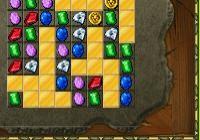Jewel Quest Mysteries: The Curse of the Emerald Tear (Nintendo DS) Review
By Shane Jury  27.05.2010
27.05.2010

Since its PC release back in 2004, developer iWin has taken the Indiana Jones-inspired Jewel Quest concept and ran with it in many experimental games, all the while keeping the core concept intact. After first porting the original idea to mobile phones, then later to Xbox Live Arcade, iWin have tried combining it with other things - to mixed opinion - such as Solitaire. In Jewel Quest Mysteries: The Curse of the Emerald Tear's case, storyline-based mysteries have been added, with the DS title being released with a separate game, Mysteryville, on the same cartridge. Does the extra game outshine the original idea, or does the addictive Jewel Quest concept 'iWin' out in the end?
Although Jewel Quest Mysteries and Mysteryville are completely separate - both are selectable right from boot-up - both follow an eerily similar premise in the method by which you are required to solve cases. The stories differ somewhat, however: in Jewel Quest Mysteries, you take control of treasure seekers Rupert and Emma as they hunt for gold and jewels in the tombs of Egypt. In Mysteryville, the spoils are perhaps less lucrative: your character is a reporter for a country life magazine, and you are assigned to investigate a series of strange cat disappearances.
Although the first game is the only one to use the actual Jewel Quest concept, wherein you are given a grid to move and link coloured jewels to wipe them from the board, both games present the player with a static screen of an environment, and a list of items to find within it. In the headlining game, item-finding and jewel-aligning must be balanced as you puzzle your way through time limited rounds, while Mysteryville tasks you only with the searching part. Both, though, carry the same penalty for misplaced taps, namely time deduction, which means that there's no spammy hit-the-screen-everywhere-until-you-succeed option if you are struggling to proceed. As you'd expect, the touch screen comes in handy for the concept, as finding and touching said items is far more intuitive than using buttons.
What isn't, however, is the cumbersome D-pad controls used to scroll around the screen. It is far too slow, and there's no option to speed it up. You can use the touch screen to do the same job, but then you run the risk of hitting the wrong places and affecting your time limit. There is, thankfully, a hint-based system in both games, with Jewel Quest Mysteries making it particularly useful by also putting collectable coins and jewels in the environments to find, but this system is limited in use for each level, and only helps find the top item of your list on the top screen. It does not help matters that a few particular items are very abstract in name, and hard to distinguish from the background, so chances are you'll be scanning relentlessly like Samus on speed - which, of course, a ticking clock will not help.

Jewel Quest Mysteries does helpfully provide a change from the Where's Wally/Waldo-esque gameplay, with both the original concept and another form of it. The new variety becomes a decent side-game, and uses the jewels found in your search, requiring you to place them into a grid of varying sizes to form a flawless gold grid. The original game, much like Zoo Keeper, gives you a grid, by which you need to touch and shift coloured gems to make rows of three or more, and as they disappear the squares behind them are coloured gold; completion arrives when the whole grid shines. This element of the game in particular is as strong as ever, with reliable touch screen control, although the time limit is still in effect.
Both Jewel Quest Mysteries and Mysteryville follow storylines, but the presentation of each is, to put it bluntly, basic. Static sprite-grabs of characters and non-voiced text conversations keep the stories going, and it's competently written, but the extremely simplistic appearances do not do the rest of the game any favours. The background music is also entirely forgettable, but pleasant enough to listen to.
The complete package of the two games is only single player-orientated, but also fairly lengthy even when not taking repeat play of failed levels into account. It is a shame iWin didn't make at least the core Jewel Quest game a wireless or online multiplayer experience, as it would have potential in that area, and here all it has to fall back on is a high score table. For the older gamer, and those interested in a simplistic adventure coupled with a fun puzzle premise, Jewel Quest Mysteries may be worth a go. The rest of us, though, can safely stroll past on this one.

Cubed3 Rating
Average
A passable attempt at integrating the Jewel Quest game with other genres, with a functional-if-flawed game emerging as the output. Immensely minimalistic presentation, environmental distinguishing issues, and a strong lack of replay factor hold back the end product; it's safe to say that there are other DS games that do puzzles and point-and-click far better.
Comments
Comments are currently disabled

 Sign In
Sign In Game Details
Game Details
 Out now
Out now  Out now
Out now  TBA
TBA  Out now
Out now  Subscribe to this topic
Subscribe to this topic Features
Features







 Top
Top

